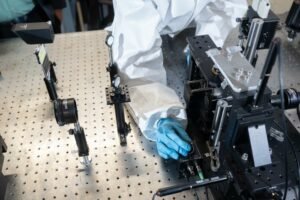Engineers from the Georgia Institute of Technology say they have developed a breakthrough method for printing incredibly small metallic nanostructures using the power of light. While some methods to accomplish this same task currently exist, they are slow and cumbersome, preventing their use at any viable commercial scale.
The engineers believe that their method, referred to as superluminescent light projection, represents a breakthrough that could enable revolutionary technological advancements in a wide range of industrial, commercial, and scientific applications, including advances in nanotechnology.
Printing Infinitesimally Small Objects by Harnessing the Power of Light
As technologies continue to advance, scientists and engineers have developed an increasing need for objects printed at the nanoscale, meaning hundreds of times smaller than a human hair. This is especially true in extremely advanced nanotechnologies like power generation and sensing, as well as novel medical procedures that previously only existed in science fiction.
Unfortunately, the current method for printing metallic nanostructures involves the use of an extremely powerful light source known as a femtosecond laser. These pieces of laboratory-level equipment typically cost hundreds of thousands of dollars, making the process cost-prohibitive. They also print metallic nanostructures very slowly. These two limitations have made scaling up this type of nanoscale manufacturing of advanced devices and components virtually impossible, limiting their uses almost exclusively to laboratory settings.


“As a scientific community, we don’t have the ability to make enough of these nanomaterials quickly and affordably,” explained Sourabh Saha, an assistant professor in the university’s George W. Woodruff School of Mechanical Engineering, “and that is why promising technologies often stay limited to the lab and don’t get translated into real-world applications.”
Frustrated by these limitations while also encouraged by the incredible breakthroughs that might lie on the horizon, Saha and Jungho Choi, a Ph.D. student working in the same lab, decided to explore methods of printing objects by using the were of light that were significantly faster and cheaper than those currently available.
“The question we wanted to answer is, ‘Do we really need a high-intensity femtosecond laser to print on the nanoscale?’” said Saha. “Our hypothesis was that we don’t need that light source to get the type of printing we want.”
Breakthrough Method Faster and Cheaper Than Conventional Process
To start, the researchers began looking for a type of light source that could be focused in a similar way to femtosecond lasers. They also needed to find a light source that was low power and low cost enough that it was viable to scale up commercially.
After some investigation, Saha and Choi landed on something called superluminescent light-emitting diodes (SLEDs). SLEDs emit a light that is a billion times less intense than a femtosecond laser, significantly reducing power needs. They are also commercially available, making the idea of creating a scalable process for printing metallic nanostructures seem tantalizingly close.
With their light source in hand, the team began developing their projection system. This meant creating a customized device that could convert digital images into optical images and then print them onto a glass surface. The result was a device that works a lot like a digital projector, only but produces much more sharply focused images.


Next, the duo created their own customized printing ink out of metal salt and then added some additional chemicals to help the ink effectively absorb light. After that, it was time to run a real-world test, and the process worked.
“When light from their projection system hit the solution, it caused a chemical reaction that converted the salt solution into metal,” the press release announcing the breakthrough system explains. “The metal nanoparticles stuck to the surface of the glass, and the agglomeration of the metal particles creates the nanostructures.”
Not only was their SLP process a success, but they had accomplished their two main goals of reducing power usage and production times. In fact, they say their method is 480 times faster than the current conventional method, as well as 35 times cheaper, thanks to an SLED that costs around $3,000.
Scalable Printing using the power of Light Could Revolutionize Numerous Cutting-Edge Nanotechnologies
In their published study, which appears in the journal Advanced Materials, the engineering team says their process could represent a significant breakthrough that could transform a field beholden to technologies and processes that are prohibitively slow and expensive.
“At present, only top universities have access to these expensive technologies, and even then, they are located in shared facilities and are not always available,” Choi said. “We want to democratize the capability of nanoscale 3D printing, and we hope our research opens the door for greater access to this type of process at a low cost.”
Above: Video featuring the novel nanoprinting process with superluminescent light projection (SLP) (Credit: Georgia Institute of Technology).
Moving forward, the team believes their system can be particularly useful to the fields of optics, plasmonics, and pretty much any pursuit that involves using metallic nanostructures. They also feel that leading a revolution in the scalable printing of nanoscale objects using the power of light could have wide-ranging benefits to all of humanity.
“I think the metrics of cost and speed have been greatly undervalued in the scientific community that works on fabrication and manufacturing of tiny structures,” Saha said. “In the real world, these metrics are important when it comes to translating discoveries from the lab to industry. Only when we have manufacturing techniques that take these metrics into account will we be able to fully leverage nanotechnology for societal benefit.”
Christopher Plain is a Science Fiction and Fantasy novelist and Head Science Writer at The Debrief. Follow and connect with him on X, learn about his books at plainfiction.com, or email him directly at christopher@thedebrief.org.

